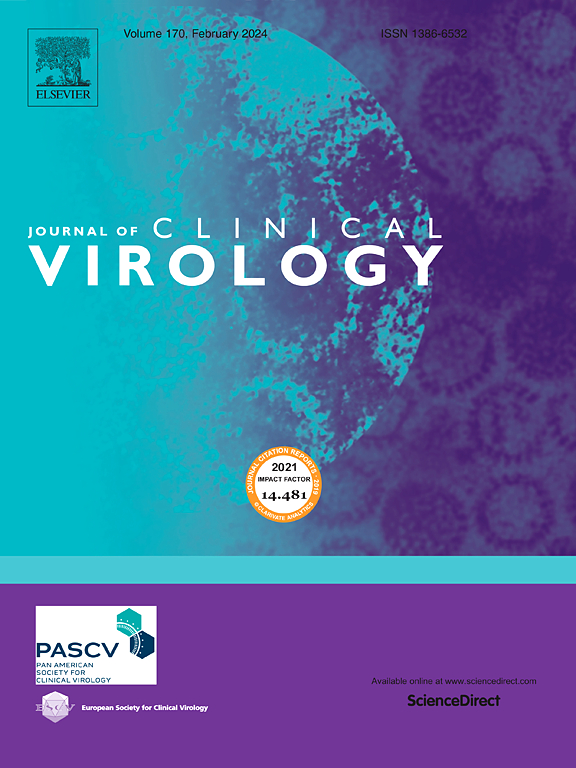SpikeID:通过刺突测序快速、公正地鉴定SARS-CoV-2变异
IF 3.4
3区 医学
Q2 VIROLOGY
引用次数: 0
摘要
严重急性呼吸综合征冠状病毒2 (SARS-CoV-2)关注变异体(VOCs)的特征是病毒刺突蛋白S1结构域的不同突变。该结构域包括n端结构域、受体结合结构域和部分裂解位点区域。虽然SARS-CoV-2其他基因组区域的突变会影响VOC潜力,但S1结构域对于识别变体和评估抗原进化和免疫逃逸潜力具有特别重要的意义。方法建立了基于spike S1扩增子测序的快速高通量测序方法SpikeID,用于无偏检测和鉴定SARS-CoV-2变异体。我们对从2021年10月到2024年1月在全球传播的622个临床生物标本进行了SpikeID检测与Illumina全基因组测序的基准测试。结果与全基因组测序相比,spikeid明确检测了100%的who指定voc,并在纽约市(NYC)地区确定了流行率≥1%的PANGO谱系,准确率为93%。这种准确性的降低主要是由于PANGO谱系只能通过S1结构域外的突变来区分。我们证明了SpikeID检测在纽约市出现和随后出现的Omicron和Omicron衍生谱系时的实用性和可扩展性,并表明我们的方法能够经济、可靠和近实时地检测新兴谱系。本文章由计算机程序翻译,如有差异,请以英文原文为准。
SpikeID: Rapid and unbiased identification of SARS-CoV-2 variants by spike sequencing
Background
Severe acute respiratory syndrome coronavirus 2 (SARS-CoV-2) variants of concern (VOCs) are characterized by distinct mutations in the S1 domain of the viral spike protein. This domain encompasses the N-terminal domain, the receptor-binding domain, and part of the cleavage site region. While mutations in other genomic regions of SARS-CoV-2 can impact VOC potential, the S1 domain holds particular importance for identifying variants and assessing antigenic evolution and immune escape potential.
Methods
We describe a rapid high-throughput sequencing-based assay, SpikeID, for the unbiased detection and identification of SARS-CoV-2 variants based on spike S1 amplicon sequencing. We benchmarked the SpikeID assay against Illumina whole-genome sequencing across 622 clinical biospecimens, representing lineages that circulated globally from October 2021 to January 2024.
Results
SpikeID unambiguously detected 100 % of WHO-designated VOCs and identified PANGO lineages circulating at ≥1 % prevalence in the New York City (NYC) area with 93 % accuracy in comparison to whole-genome sequencing. This reduction in accuracy was largely due to PANGO lineages that are only distinguishable by mutations outside the S1 domain.
Conclusions
We demonstrate the utility and scalability of the SpikeID assay during the emergence and subsequent surge of Omicron and Omicron-derived lineages in New York City, and show that our approach enables cost-effective, reliable, and near-real-time detection of emerging lineages.
求助全文
通过发布文献求助,成功后即可免费获取论文全文。
去求助
来源期刊

Journal of Clinical Virology
医学-病毒学
CiteScore
22.70
自引率
1.10%
发文量
149
审稿时长
24 days
期刊介绍:
The Journal of Clinical Virology, an esteemed international publication, serves as the official journal for both the Pan American Society for Clinical Virology and The European Society for Clinical Virology. Dedicated to advancing the understanding of human virology in clinical settings, the Journal of Clinical Virology focuses on disseminating research papers and reviews pertaining to the clinical aspects of virology. Its scope encompasses articles discussing diagnostic methodologies and virus-induced clinical conditions, with an emphasis on practicality and relevance to clinical practice.
The journal publishes on topics that include:
• new diagnostic technologies
• nucleic acid amplification and serologic testing
• targeted and metagenomic next-generation sequencing
• emerging pandemic viral threats
• respiratory viruses
• transplant viruses
• chronic viral infections
• cancer-associated viruses
• gastrointestinal viruses
• central nervous system viruses
• one health (excludes animal health)
 求助内容:
求助内容: 应助结果提醒方式:
应助结果提醒方式:


